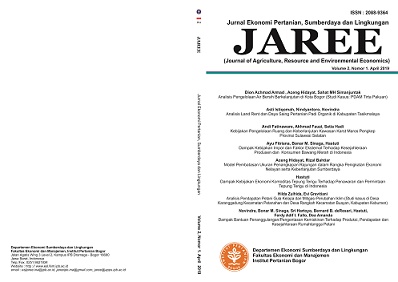MODEL PEMBATASAN UKURAN PENANGKAPAN RAJUNGAN DALAM RANGKA PENINGKATAN EKONOMI NELAYAN SERTA KEBERLANJUTAN SUMBERDAYA
Abstract
Blue swimming crab (blue crab) is one of the fisheries resource commodities that have high economic value, so the opportunities for export to different countries is widely open.Optimization of management and utilization of blue crab is important for sustaining economic benefit.This research aims to (1) analyze bioeconomic resource of blue crab in the waters of Tangerang, Jakarta Bay, Bekasi and Karawang; (2) evaluate the utilization of blue crab resources processed by “mini plant” in Dadap Village Tangerang Regency; (3)feasibility study of blue crab resource utilization based on size. Research locationresource for management wasconducted in the waters of Tangerang, Bay of Jakarta, Bekasi, Karawang and the utilization of blue crab was done in Dadap Village, Tangerang Regency. The research method used is the case study method. Sampling method used was purposive sampling for fishermen, the census for mini plant, and random sampling for small crab processing system. Bioeconomic Gordon-Shaefer, analysis of productivity, and Cost Benefit Analysis (CBA) was used to analyze the data. Bioeconomic analysis results showed that the actual harvest is 1,152 tons/year, it has not exceeded the MEY level andeconomic overfishing has not occurred. Opportunity of increasing effort is possible and process of blue crab with size of above eight centimeters is more profitable and encourage a more stable stock of blue crab, processing of crab with optimum production, and increase efficiency of“mini plant”management in the long run.Government policies in controlling mesh size of blue crab fishing gear ≥ 8 cm should be strictly enforced, and processing plants do not accept and produce small crab <8 cm, in order to achieve sustainable blue crab resource managementDownloads
References
Boyce, J.R. 2004. Instrument choice in a fishery. Journal of Environmental Economics and Management 47:183-206.
Departemen Kelautan Dan Perikanan Direktorat Jenderal Perikanan Tangkap. 2010. Laporan Statistik Perikanan Tangkap Indonesia.
Doll J.P., Orazem F. 1984. Production Economics : Theory With Applications. New York (US): John Wiley and Sons Inc.
Fauzi, A. 2010. Ekonomi Perikanan Teori, Kebijakan, dan Pengelolaan. Gramedia Pustaka Utama. Jakarta.
________. 2006. Ekonomi Sumberdaya Alam dan Lingkungan Teori dan Aplikasi. Gramedia Pustaka Utama. Jakarta.
Gittinger, J.P. 1986. Analisis Ekonomi Proyek-proyek Pertanian. Penerjemah Slamet Sutomo dan komel Mangiri. Universitas Indonesia Press. Jakarta.
Grafton, R.Q., et al. 2006. Incentive-based approaches to sustainable fisheries. Canadian Journal of Fisheries and Aquatic Sciences 63:699-710.
Josileen, J. and N.G. Menon. 2009. Fishery and growth parameters of the blue swimmer crab Portunuspelagicus (Linnaeus, 1758) along the Mandapam coast, India. Central Marine Fisheries Research Institute, Cochin-682-018
Kusumastanto, T., et al. 2007. Konsepsi pengelolaan sumberdaya periknan Laut Arafuru dalam rangka terciptanya pemanfaatan sumberdaya yang lestari. Paper. Institut Pertanian Bogor. Bogor.
Nazir, M. 1988. Metodologi Penelitian. Cetakan Ketiga. Ghalia Indonesia. Jakarta




